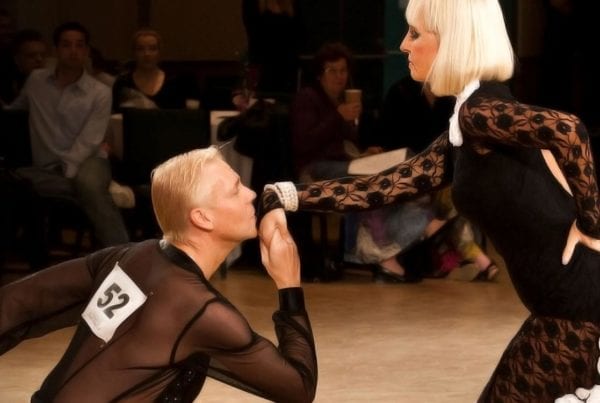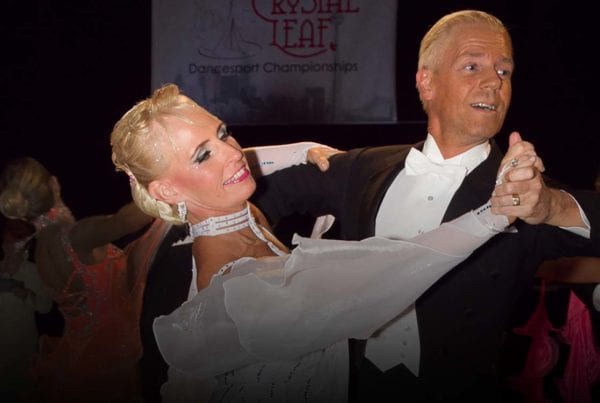The Paso Doble is a dramatic dance reflecting the movement of a matador and his cape. The dance is often avoided in social settings, which is a shame, as it isn’t difficult to learn.
We've put together a complete routine choreographed to Spanish Gypsy Dance, the most common musical selection for this dance. Consisting of some 28 phrases of 8, 12 or 10 bars of music, the routine helps dancers understand how they can perform the figures and put them together. The routine is also listed in our downloadable choreography guide.
You'll learn Bronze, Silver and even some Gold figures, and you'll learn how to put the different figures together to create interesting choreography for your dancing. Each group includes one new figure that we show you in considerable detail so that you understand the principles you'll need to know to look great on the dance floor and to lead or follow the figure effectively.
This video is available to all Delta Dance members.
Demonstration of Routine
George and Wendy dance the Paso Doble routine to show how it moves around the floor, and to show where the individual figures take place on the floor. This is being danced in a social style, the way it would typically be performed in a social setting.
Curriculum
This course totals nearly three hours in length, but is divided into 21 different segments to make it easy for you to learn in a proven step-by-step process.
Introduction to Paso Doble (length 3:38)
A brief introduction to the dance, the music, and our approach to the routine.
Paso Doble Posture and Movement (length 14:25)
A detailed look at Paso Doble posture, the various leg actions and how they relate to movement, shaping, and Paso holds/positions.
Phrase 1: Sur Place (length 2:23)
We start the routine with this very basic action. We've designed it this way specifically to give social dancers a chance if the music has already started and they are still setting up.
Phrase 2: Chasses and Drag (length 12:00)
We now begin to move, using Chasses to the Right followed by a fun and easy figure called the Drag.
Phrase 3: Twist Turn (length 10:31)
The Twist Turn is similar to the version used in Tango, but with an important distinction.
Phrase 4: Promenade and Chasses (length 5:39)
This figure is simple to perform, and turns the alignments to be opposite of where the figure starts.
Phrases 5 & 6: Separation with Fallaway Ending (length 13:12)
There are four different kinds of Separation in the Paso Doble. We utilize three of them in the routine, but we show you the basic Separation and the more complex one utilizing the Fallaway Ending that is applied in this routine.
Phrase 7: Open Telemark (length 10:44)
The Open Telemark turns strongly to the left, changing the alignments on the floor. We begin backing the Line of Dance and end facing Center.
Phrase 8 - Promenade Spins (length 11:15)
The Traveling Spins from Promenade Position involve spiral turns for the lady, making this one of the more challenging figures for new dancers.
Phrases 9 & 10: La Passe (length 13:40)
La Passe is one of the most dramatic figures in Paso Doble. It's also one that is frequently danced poorly. Here's the proper technique.
Phrase 11: Promenade and Counter Promenade (length 6:34)
The Promenade is familiar but Counter Promenade Walks bring with them a unique challenge that often creates problems when this figure is performed.
Phrase 12: Grand Circle (length 8:55)
A beautiful figure that encapsulates the visual representation of the matador circling his cape around him.
Phrase 13: Chasses and Drag (length 2:06)
We repeat this combination of figures, used at the start of the routine, to minimize the amount of complexity of the routine.
Phrases 14 & 15: Chasses Cape (length 12:27)
One of the most dramatic figures in the Paso Doble syllabus, the Chasse Cape illustrates the matador swinging his cape from one side to the other as he moves sideways.
Phrases 16-18: Flamenco Section (length 14:25)
Utilizing Spanish Line followed by Flamenco Taps, this is a fun part of the routine where both partners take on the characteristic of Flamenco dancers.
Phrases 19 & 20: Sixteen (length 5:45)
The Sixteen is identical to La Passe, except that it has no forward progression.
Phrase 21: Coup de Piquet (length 4:54)
The Coup de Piquet is not a difficult step, but dancers often struggle with it because it comes up so suddenly that they simply forget to do it.
Phrases 22 & 23: Syncopated Separation (length 7:34)
This is the second version of the Separation that we are using in the routine. It isn't difficult but the number of steps and the syncopated timing can make it challenging.
Phrase 24: Chasses to Right (length 3:03)
Again we provide an opportunity to use basic Chasses, as we did earlier, to minimize the complexity of the routine. These Chasses need to position the couple so that the main audience is behind the gentleman.
Phrases 25 & 26: La Passe (length 1:24)
The La Passe here is identical to the one we used earlier in the routine. It turns the alignment to the opposite direction where the figure began, now facing the main audience.
Phrases 27 & 28: Separation with Lady's Caping Walk (length 8:50)
We finish the routine with the third version of the Separation, followed by a fun opening action that matches the timing of the final highlight.

Members-Only Content
This content is available to Delta Dance members only. Membership grants you access to special content, our members-only videos, and downloadable choreography and technical guides. You may cancel at any time.
Click here to register or login below with your membership credentials.













